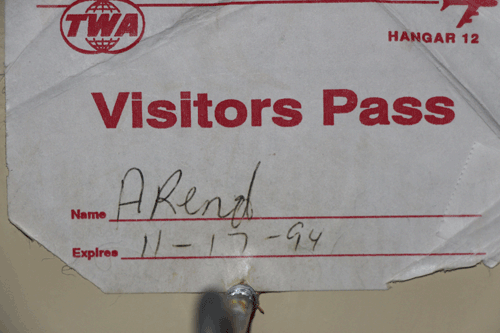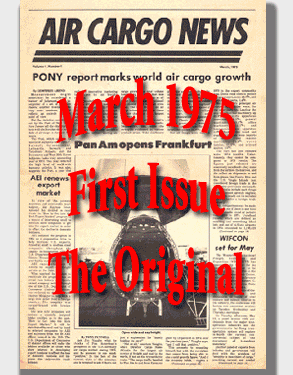
 ometimes
when out doing a story for FlyingTypers,
we chance upon someone who has been around but whom we haven’t
seen for a while, and past encounters seem more like the snippets of
some dream we aren’t certain truly happened. ometimes
when out doing a story for FlyingTypers,
we chance upon someone who has been around but whom we haven’t
seen for a while, and past encounters seem more like the snippets of
some dream we aren’t certain truly happened.
Once upon a time we met Robert Uttmark in a small room near a converted
part of Hangar 12 at John F. Kennedy Airport, in an office off to the
side of an area allocated to cargo acceptance.
The area for air cargo in Hangar 12 was
the tiniest part of a building otherwise filled with B727 and Lockheed
L-1011 aircraft. It was a space where those planes had their mechanics
looked over, back during a time when JFK was home to that type of work.
TWA Cargo boss Robert Uttmark was always
a belly-lift devotee—both for the steady return revenue and the
oft-repeated verse, “billionaires turned into millionaires with
freighters.”
TWA was in terrible, and as it turned
out, fatal trouble.
Management had landed from bad to worse
as the Icahn stewardship-era had according to several reports left the
legendary carrier mortally wounded with TWA Getaway Tours—a money
machine sold off along with everything else not nailed down as the corporate
raider exited stage left, reportedly with 100 million or (maybe it was
a billion) in ticket stock.
TWA would not quit, and its people were
tough and dedicated.
But if Howard Hughes was notorious for
rerouting a scheduled flight on a whim, Icahn took off from TWA with
the ability to ground the airline altogether, which is just what happened.
Robert Uttmark managed to keep lucrative
airmail contracts and other revenue streaming into company coffers despite
the lack of much good press or cargo lift in the 1011s.
But he sold what he could fill, and delivered
as booked the cargo that was vital as Trans World Airlines gasped for
air on the long slow descent to its final landing.
The year was 1994, and it was the week
before Thanksgiving, November 17, when Bob and I last talked to each
other face to face.
But just recently as I walked into United
Cargo headquarters in Chicago, a low cubicle announced:
“Is that Geoffrey Arend?”
And there he was, 19 years later.
“Never Say Die Bob,” still
pushing the mail revenue stream, except this time at UA. He has served
for the past dozen years as Manager Postal Sales.
Today at United, that business adds up
to about 15% of cargo revenue throughput.
Now that the airline mail business is
online and everyone seems to have an ipad of one size or another, much
has changed, but some things have stayed the same.
“The head of Royal Mail said recently
‘We are in the parcel business, but we also deliver letters,’
and that pretty much says it all,” Bob said.
“I think that is the case for all
post office activity around the world right now,” Bob Uttmark
said.
“Big changes also in electronics
in the mail business; scanning requirements and communications have
come into being in the past few years.
“Now every movement needs to be
constantly traced and consignments need to arrive on time, period.
“Handling mail in 2013 is much more
a time definite business than at any other time in history, with demands
continuing to go up.”

Robert Uttmark has given his life to air
cargo for the past 41 years. He moved to St. Louis to be near TWA HQ
and never left, choosing to commute to Chicago to continue his career
at United.
We wonder what he might do to change the
air cargo business for the better.
“The thing that would cause a paradigm
shift for the better in air cargo would be to change the payment structure.
“Look how the airline passenger
business operates.
“Passengers have made a financial
commitment when they book a seat before they travel on an airplane.
“There is no such thing as paying
weeks afterwards in air travel as is the norm in air cargo.
“There are many benefits for air
cargo to follow the pay up front model of the passenger business, including
certainty and even less shopping for rates.
“So the moment you book a pallet,
pay for it.
“There are all kinds of triggers
to provide refunds, discounts, or even fly for free if the carrier doesn’t
perform.”
 |

“The biggest single reason to use
us is our unmatched global network.
“And it is not just the UA network
alone any more; in fact, we carry mail with most of our Star Alliance
partners and some additional airlines.
“What that means is that we don’t
just go to, say, Frankfurt as a destination, but we are able to service
all the destinations beyond FRA for the postal service.
“Utilizing United affords the U.S.
Postal Service access to some very difficult to reach places in the
world as we go into partner hubs and use their starburst schedule to
everywhere they fly.
“We add value, not to mention convenience,
to the U.S. Post business proposition.”

Robert said that he no longer gets out
to postal conventions, although the UA director of mail optimization,
David King, does.
“There was a time in my life for
those travels, but today David does a great job handling that work,
which included an appearance at WCS Doha, where he discussed the mail
as part of that track during IATA air cargo week.”
Looking at Robert Uttmark, we recall that
for many years in any open meeting, the guy who talked airmail on panels
of airline people usually did so after drawing the short straw.
But still today Bob will tell you:
“I always liked it and never minded
talking about the postal business.”
Bob Uttmark served in the U.S. Navy and
after his hitch in service to his country, he went out job hunting.
“I was attending State University
(Bob received a Masters Degree in Economics) and answered an ad in The
New York Times and began my career at TWA in 1972.
“I guess the training in economics
has helped in my airline career.
“I am the last guy who would ever
undervalue our services,” Robert Uttmark said.

 No, it was not a dream all those years
ago.
No, it was not a dream all those years
ago.
With interview and story completed in
2013, I found the proof.
After interviewing Bob Uttmark in 1994
inside Hangar 12 JFK, I went home and noticed one of those paper badge
stickers (which used to be given out all the time at secure installations
or trade shows) affixed to the lapel of my suit jacket.
I recall in 1994 having this terrible
feeling that TWA might go away, out of business forever.
So I took that sticker and pasted it above
the tie-rack inside my bedroom closet. It has hung there ever since.
I’m so glad to see Bob doing what
he loves to do and even more so I love seeing someone who understands
what a privilege it is to work and genuinely love this air cargo business.
The sky is no limit for what Bob Uttmark
can still bring to air cargo.
Geoffrey/Sabiha
|





 No, it was not a dream all those years
ago.
No, it was not a dream all those years
ago.
